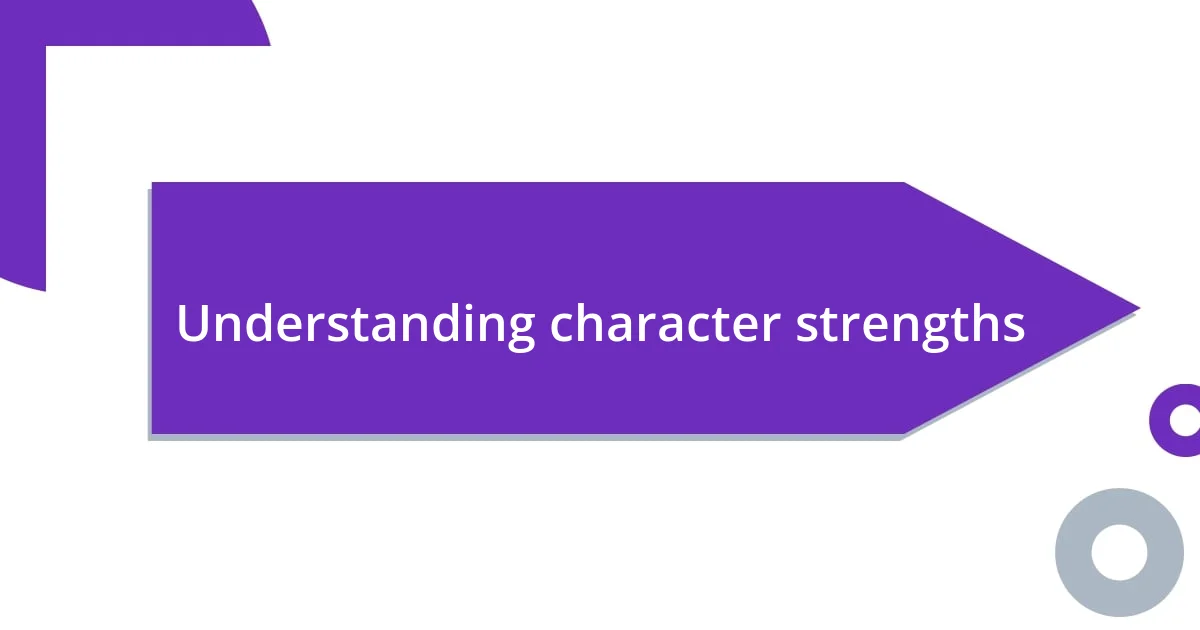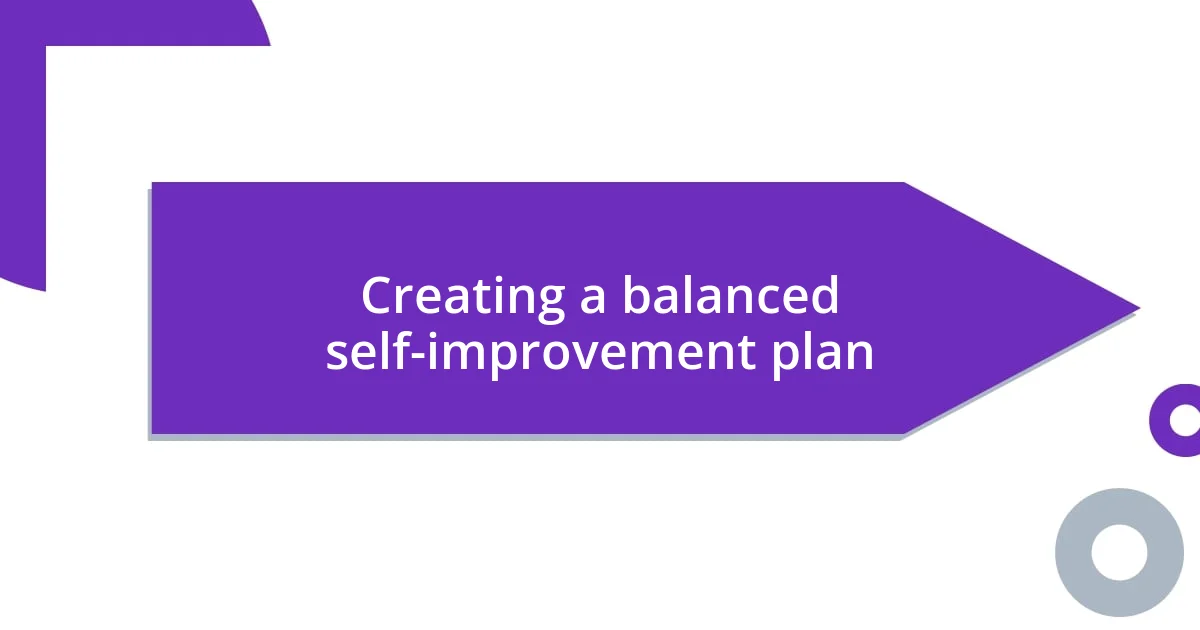Key takeaways:
- Understanding and embracing character strengths, like resilience and empathy, can significantly enhance personal growth and deepen relationships.
- Identifying personal weaknesses through self-reflection and feedback is essential for improvement and self-awareness.
- Creating a balanced self-improvement plan that integrates strengths and weaknesses, along with regular progress measurement, fosters continuous development and motivation.

Understanding character strengths
Character strengths are the positive traits that define who we are, shaping our actions and interactions with others. Reflecting on my own life, I can recall moments when my resilience helped me overcome challenges, like the time I faced a tough project at work. It made me realize how powerful embracing my strengths could be in navigating difficulties.
Have you ever stopped to consider which character strengths come most naturally to you? For instance, I’ve found that my curiosity drives me to explore new ideas and experiences. This exploration not only fuels my personal growth but also deepens my connections with those around me, as I often share my discoveries and insights with friends and family.
Understanding these strengths isn’t just about self-awareness; it’s about harnessing them to enhance your relationships and improve your life. I remember a time when I leaned on my empathy to support a friend going through a tough breakup. It was rewarding to see how my ability to understand their feelings fostered a stronger bond between us, reminding me of the profound impact our strengths can have on others.

Identifying personal weaknesses
Identifying personal weaknesses can feel daunting, yet it’s a crucial step towards personal growth. I recall a time when I struggled with procrastination, often waiting until the last minute to complete tasks. That habit not only added unnecessary stress but also diminished the quality of my work. Recognizing this weakness was uncomfortable, but it opened the door for improvement.
To help pinpoint weaknesses more clearly, here are some practical steps you can take:
- Self-reflection: Take time to think about past experiences where you didn’t meet your expectations.
- Seek feedback: Ask trusted friends or colleagues for their perspectives on areas where you may lack strength.
- Journal your thoughts: Writing down your feelings and challenges can reveal patterns that indicate weaknesses.
- Emotional triggers: Pay attention to what frustrates or upsets you; these feelings can highlight areas for growth.
- Personality assessments: Tools like the Myers-Briggs Type Indicator or StrengthsFinder can provide useful insights into your weaknesses.
By delving into these areas, I discovered that addressing my weaknesses didn’t mean defeating them; instead, it cultivated a deeper understanding of myself and my journey.

Assessing strengths and weaknesses
Assessing strengths and weaknesses requires an honest look in the mirror. I remember sitting down with a cup of tea, ready to write down my strengths and weaknesses. As I scribbled down resilience and creativity, I felt a sense of pride wash over me. Yet, when I reached for my weaknesses, like impatience and a tendency to avoid conflict, it stung a bit. It’s challenging to confront aspects of ourselves that we’d rather ignore, but this reflection is where real growth begins.
A powerful method I’ve used for assessing my character is through comparison. Creating a simple table helped me visualize my strengths against my weaknesses. I could see them side by side, which made it easier to identify improvements I could make. It was enlightening to witness how some strengths could complement my weaknesses if I allowed them to work in harmony. This visualization sparked a constructive dialogue within myself about moving forward.
Self-assessment doesn’t have to feel isolating, either. I invite trusted friends to share their observations; their insights often reveal strengths I might overlook. For example, while I may view my meticulous nature as a flaw, my friends see it as a dedication to detail that enhances our teamwork. This layered understanding is essential when it comes to assessing strengths and weaknesses honestly and compassionately.
| Strengths | Weaknesses |
|---|---|
| Resilience | Impatience |
| Creativity | Avoiding conflict |
| Curiosity | Procrastination |

Strategies for leveraging strengths
When it comes to leveraging strengths, I find that the first step is to align them with my daily activities. For instance, I’ve always excelled in brainstorming creative ideas, so I made it a point to position myself in roles that require innovation. Have you ever noticed how much more fulfilling tasks become when you play to your strengths? I truly believe that when we embrace what we do best, we don’t just enhance our performance; we also ignite our passion for what we do.
Another effective strategy is to collaborate with others who possess complementary strengths. I remember a project where my organizational skills were paired with a colleague’s technical expertise. It was exhilarating to see how our different strengths created a synergy that led to outstanding results. How often do you work alongside someone whose talents bridge your gaps? This approach not only amplifies our capabilities but fosters a sense of teamwork and camaraderie that can be quite motivating.
Lastly, I’ve learned that reflecting on past successes can offer powerful insights. I often revisit moments when I leaned into my strengths—like when I led a volunteer initiative successfully. That experience solidified my belief in my leadership abilities. Do you ever take time to celebrate your achievements? Acknowledging those moments not only boosts my confidence but reinforces the value of my strengths, encouraging me to leverage them in future endeavors.

Techniques for improving weaknesses
To tackle weaknesses, I’ve found that setting small, achievable goals can make a significant difference. For example, I’ve struggled with procrastination, so I committed to dedicating just ten minutes a day to start tasks I usually avoid. This tiny commitment created momentum and gradually transformed my approach, helping me see that breaking projects into smaller pieces lessens the intimidation factor. Have you ever noticed how a little progress can shift your entire mindset?
Another technique I’ve incorporated is seeking feedback and accountability from others. I remember mentioning my goal of improving my conflict resolution skills to a friend. Their encouragement helped me stay on track, and they offered me practical advice to navigate challenging conversations. Sometimes, just having someone check in can be a game-changer. Have you considered who in your life might help support you in addressing your weaknesses?
Lastly, I dedicate time to reflection after each week. Reviewing situations where my weaknesses played a role helps me identify patterns and learn from them. For instance, after an uncomfortable debate in a group setting, I noted how avoidance only prolonged tension. This reflection process allowed me to explore alternative actions for the next time such a situation arises. When you take a moment to reflect, how do you feel about your growth? Embracing these lessons has fueled my desire for continuous improvement.

Creating a balanced self-improvement plan
Creating a balanced self-improvement plan starts with a clear understanding of your current abilities and areas for growth. I once took the time to map out my strengths and weaknesses on paper, visually laying out what I excelled at and what needed attention. It was eye-opening to see it all in front of me; have you ever tried this exercise? It allows you to design a plan that acknowledges where you shine while also offering a roadmap for improvement.
In my journey, I realized the power of integrating strengths and weaknesses into a unified plan. For example, if communication is a strong suit for you but time management is a struggle, I suggest setting meetings that capitalize on your communication while incorporating tools to enhance your time management. While working on an important project, I set deadlines for myself to boost my productivity. Applying both aspects into my plan not only helped me work efficiently but also made me feel more in control of my progress. Have you thought about how interweaving your character traits could impact your growth?
Regular check-ins on your plan’s effectiveness can be transformative. I make it a routine to reflect monthly on my progress, assessing what’s working and what’s not. I remember a time when I felt stagnant, so I adjusted my approach by introducing new strategies and seeking feedback from peers. How often do you reevaluate your personal development efforts? This practice not only keeps you accountable but also ignites fresh motivation, ensuring that your self-improvement journey remains dynamic and tailored to your evolving needs.

Measuring progress over time
Measuring progress over time is an essential part of personal growth. I recall the first time I started tracking my improvements; I created a simple spreadsheet where I logged my daily efforts and any milestones. It was surprising to see how those small daily wins accumulated into something substantial over weeks. Have you ever thought about how visualizing your progress could bring a sense of achievement?
As I moved forward, I began to incorporate more qualitative measures alongside the quantitative ones. For instance, after a difficult conversation that I used to dread, I noted not just the outcome but also how I felt during and after the exchange. Reflecting on this emotional aspect helped me understand my growth on a deeper level. It was empowering to confront previously avoided situations, but it made me question: how often do we overlook the emotional markers of our progress?
Additionally, I adopted the practice of journaling to capture my journey. At the end of each month, I would write down a few key moments where I felt I had balanced my strengths and weaknesses effectively. These reflections provided clarity. I vividly remember celebrating a moment where I embraced vulnerability in a meeting, and it sparked deeper connections with my colleagues. Keeping a record of such moments not only motivates me but also serves as a reminder of how much I’ve grown. What would it mean for you to document and celebrate your own moments of progress?














